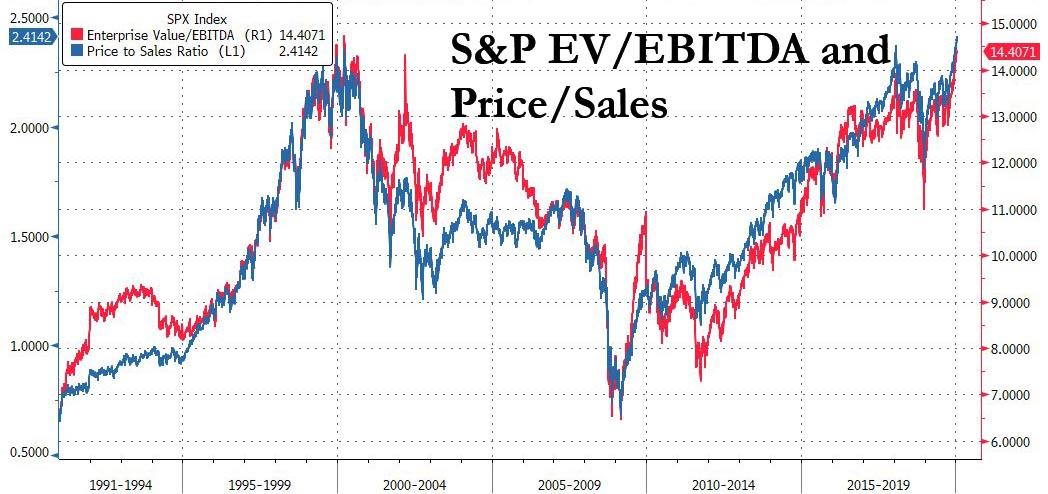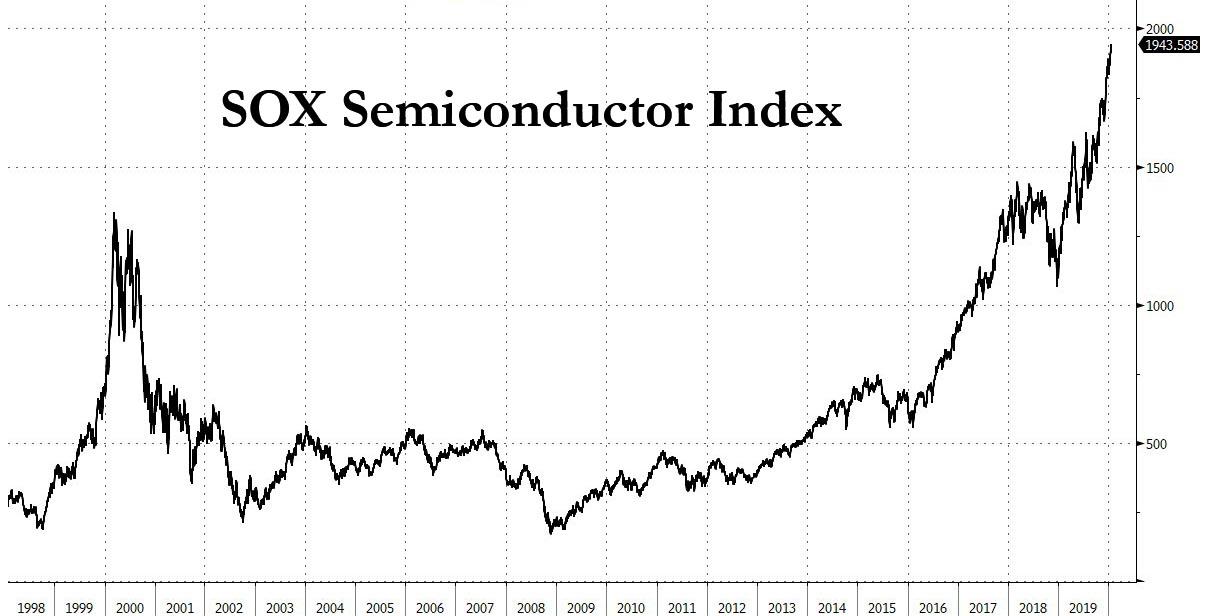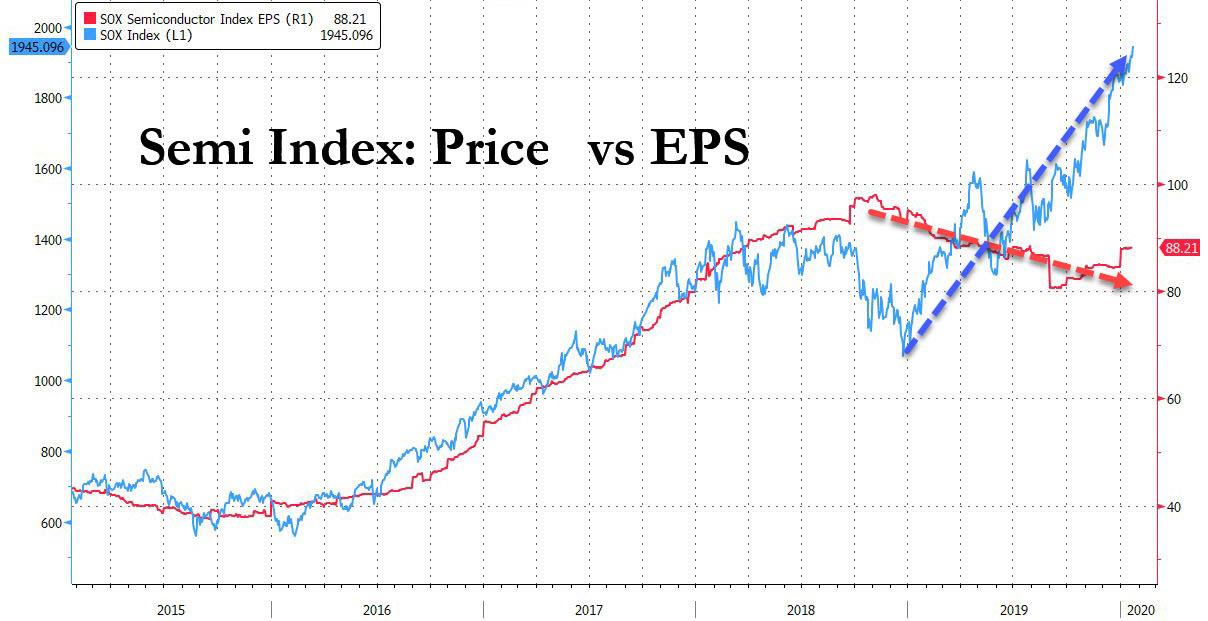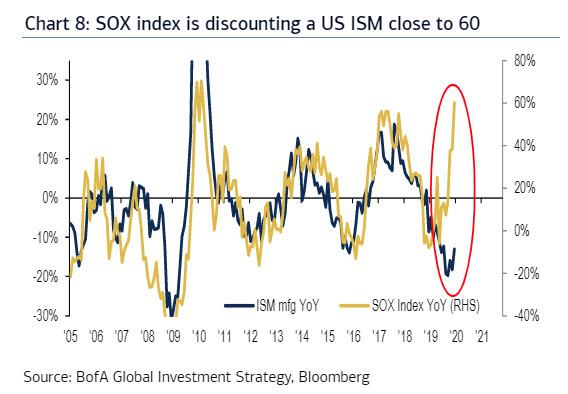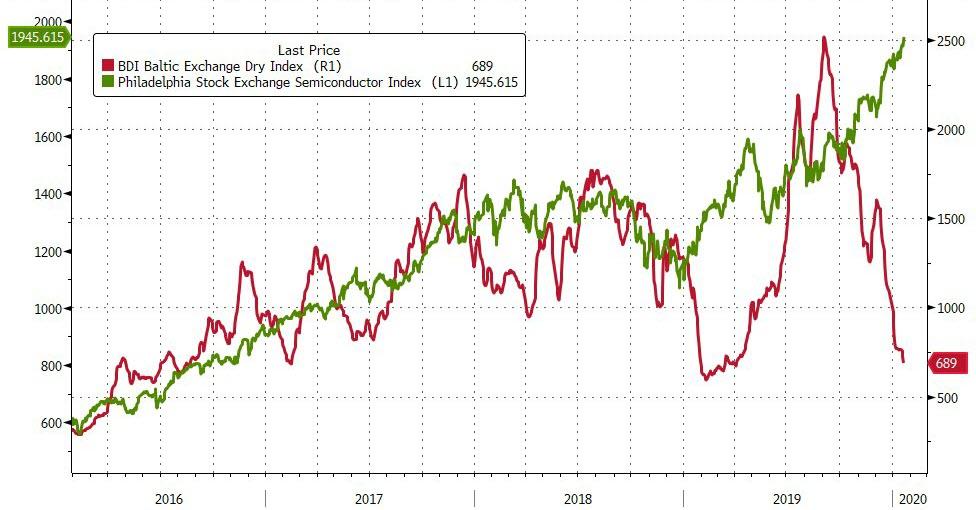Is Huawei Behind The Massive Semiconductor Bubble… And Why It’s About To Burst
For those still looking for signs that there central banks have created an epic asset bubble of unprecedented proportions, and who refuse to acknowledge that the S&P is now trading at higher multiples than the first tech bubble…
… we have just the chart for you: the SOX Philadelphia Semiconductor series.
Having successfully blown past the dot com highs, the SOX index has nearly doubled over the the past year, yet what is bizarre is that this move certainly was not on the back of earnings, which are now lower than where they were when the index was over 40% lower!
This unprecedented – and growing – stock price bubble has not escaped the attention of the “smart money” either. Indeed, as Bloomberg writes today, even as hedge funds’ exposure to tech shares remains at the highest level in at least a decade, they haven’t added to holdings in software and service providers. Instead, hedge funds are betting big on the chipmakers and hardware firms, according to prime brokerage data compiled by Morgan Stanley. Bloomberg continues:
While hedge funds don’t always get things right – their newly found affection with semiconductor makers came after a distaste that caused them pains in early 2019 – the willingness to seek out under-owned stocks is a sign they may be leery about crowding into names that were popular last year. That can be good news to a market where the risk of a rapid unwind is evident to anyone who watched crowded stocks bear the brunt of selling last September.
Unfortunately, we have a feeling that these same hedge funds will be wrong once again, and not just because the SOX index now appears to be pricing in the strongest economic recovery since the financial crisis as shown in the chart below:
In retrospect, it appears that the key reason behind the tremendous surge in the SOX has nothing to do with hedge fund buying, and little to do with the Fed, and everything to do with China’s blacklisted telecom giant that Washington views as a global security threat: Huawei.
According to the Nikkei, Huawei is scrambling to stockpile up to a year’s worth of foreign supplies for its core telecoms equipment business ahead of a widely-expected toughening of U.S. technology sanctions that may come as soon as next month.
The new U.S. measures, which Huawei and its suppliers fear could amount to a U.S. technology quarantine of the world’s largest telecoms equipment maker, are hardly surprising in light of the escalating tech war between the US and China – which is not to be confused with the far more theatrical trade war which is there mostly for public consumption and political benefit – and underlines how the two countries’ battle for global technological and military supremacy continues unabated even as Washington and Beijing sign a token “phase one” trade deal last week, which neither side will adhere to.
With a purchasing “quarantine” imminent, one whose purpose would be to cripple Huawei’s challenge to US tech dominance, what does the Chinese telecom giant do? Well, obviously, it unleashes a furious buying spree to restock on every possible piece of equipment it could need for the foreseeable future. Indeed, as Nikkei highlights, in a sign of how seriously Huawei is taking the risk of an outright U.S. ban, the company which has a roughly $70 billion global procurement budget, was prioritizing inventory for its more strategic 4G and 5G routers, switches and base stations businesses over its smartphones operation.
“It is [also] easier for Huawei to stockpile components for its telecoms equipment business as that does not require as many [imported] components as its smartphones,” one source familiar with Huawei’s thinking said. In 2019, Huawei shipped 240 million smartphones compared to millions of base station units.
Until now, Asian suppliers to Huawei such as Taiwan’s TSMC, the world’s largest contract chip maker and also Apple’s largest chip supplier, have been exempt from sale restrictions to Huawei as the components they sell have less than 25% American content. Now, however, sources told Nikkei “they fear that the mooted new rules could lower the content threshold to 10% or even 0% — as tough a level of sanctions as that faced by Iran.”
Furthermore, industry sources, Asian government officials and lawyers believe the ban could be extended to include U.S.-made equipment from companies such as Applied Materials, Lam Research and KLA Group that is used to manufacture chips.
Could Huawei – which the Nikkei notes had also stockpiled foreign supplies ahead of that move – possibly be the catalyst behind the tremendous chip rally over the past year? Think of this way: a company will pay virtually anything (especially since the money comes from Beijing) and on a very truncated timeline, which means vendors can demand any price and Huawei will have no choice but to pay it. The result: an exponential surge in the SOX index (as shown in the chart above).
That said, this frenetic purchasing spree has a deadline, and if the Nikkei is correct, it could come as soon as next month: “Although there are no details about the scope or timing of the widely rumored tightening of sanctions, two sources close to Huawei said the company anticipates it could happen next month.”
Others agree. Harry Clark, a Washington-based lawyer and chair of Orrick international trade and compliance group, told Nikkei he was aware that “the U.S. government may soon adjust these rules to expand the scope of items that are subject to Export Administration Regulation, at least with respect to transfers to export-sanctioned Huawei entities.”
Clark added that: “We understand that the U.S. government is [also] considering expanding the types of microelectronics hardware, including production equipment … to be covered by EAR controls.”
If and when an expanded ban hits Huawei, watch out below, as the it would impact a far wider array of U.S. companies such as Corning, which supplies glass to Huawei for its smartphones, as well as Asian suppliers such as Sony, liquid crystal display maker Japan Display, South Korea’s LG Display and Samsung, as well as Taiwanese contract chip makers TSMC and United Microelectronics Corp.
One can argue that just as fast as the SOX went up, it may now tumble as Huawei restrictions are extended. In fact, it could be even faster. Some U.S. hawks are reportedly seeking an outright quarantine on all sales to Huawei. They may even be seeking to ban all U.S. technology sales to China, though no consensus exists on the issue in the White House, the Wall Street Journal recently reported.
And here is the punchline from the Nikkei why Huawei singlehandedly may have led to the SOX bubble:
Even if sanctions are not tightened, the possibility that they might be has already had widespread effects. For one, Asian suppliers say the recent spike of Huawei orders has warped their production schedules out of shape.
“Huawei’s team are quite credible and mostly keep its promises. … That’s why we have helped them expand,” said one tech industry executive. “But we are also concerned that it might suddenly scale back its orders at some point.”
Another executive at a Huawei supplier added: “We have been a bit conservative in customizing production for Huawei too much in case the company adjusts it orders and later we need to find other clients.”
What happens to prices when companies scramble to find other clients? Well, let’s just say it’s not conducive to the continuation of the exponential increase in the SOX index.
There is another reason why Huawei’s involvement pushed the SOX sharply higher: the prospect of tighter sanctions has increased the urgency with which Huawei has pushed suppliers, and their supply chains, to increase production in China, just as Washington is doing much the same.
Finally, what happens of and when the US does rolls out the expanded Huawei sanctions? For the answer look no further than the Baltic Dry index which soared higher in 2019 as purchases orders were pulled forward and global commerce exploded to frontrun China’s tariffs, only to plunge now that the tentative stalemate between the US and China is in place.
And as the Baltic Dry craters to four year lows as trade, paradoxically, grinds to a halt with so much having been pulled forward from the future, is the green line above about to become the red line, and is the massive chip bubble finally pops and follows in its footsteps?
Tyler Durden
Wed, 01/22/2020 – 17:05
![]()
Zero Hedge’s mission is to widen the scope of financial, economic and political information available to the professional investing public, to skeptically examine and, where necessary, attack the flaccid institution that financial journalism has become, to liberate oppressed knowledge, to provide analysis uninhibited by political constraint and to facilitate information’s unending quest for freedom. Visit https://www.zerohedge.com
